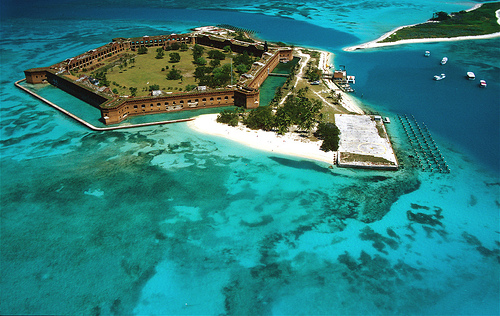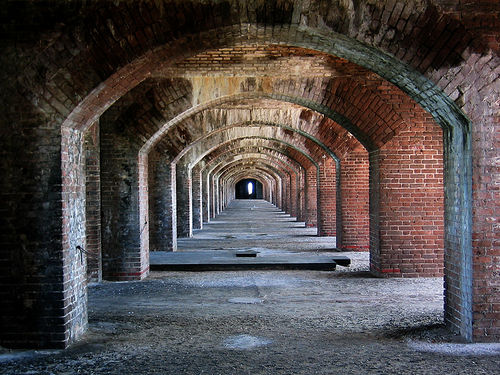


Location: Monroe County Map
Area:
64,700 acres (262 km2)
www.nps.gov/drto
Dry Tortugas National Park, a remote oceanic jewel in the Gulf of Mexico, encompasses approximately 100 square miles (259 km²) of mostly open water surrounding seven small coral and sand islands, located about 70 miles (113 km) west of Key West, Florida. Established as a national park on October 25, 1992, it builds on the legacy of Fort Jefferson National Monument (designated in 1935) to protect one of the world's most pristine tropical marine environments, historic fortifications, and diverse wildlife habitats. The name "Dry Tortugas" derives from Spanish explorer Juan Ponce de León's 1513 discovery of the islands, which he called "Las Tortugas" (The Turtles) for their abundant sea turtles; "dry" was added later to note the absence of fresh water. Accessible only by boat, seaplane, or ferry, the park is renowned for its crystal-clear turquoise waters, vibrant coral reefs (part of the third-largest barrier reef system globally), and the massive 19th-century Fort Jefferson on Garden Key—a hexagonal brick behemoth that once housed up to 1,729 men. With fewer than 80,000 visitors annually—making it one of the least-visited national parks—the site offers unparalleled solitude for snorkeling, birdwatching, and historical exploration, while facing modern challenges like climate change and invasive species.
Dry Tortugas National Park lies at the extreme western end of the
Florida Keys archipelago, in the Straits of Florida within the Gulf of
Mexico, at coordinates approximately 24°38′N 82°52′W. The park's seven
islands—Garden, Loggerhead, Bush, Long, East, Hospital, and Middle
Key—total just 143 acres (58 ha) of dry land amid 99.6 square miles (258
km²) of surrounding marine waters, forming a low-lying atoll-like
cluster rising no higher than 10 feet (3 m) above sea level. Garden Key,
the largest at 16 acres (6.5 ha), hosts Fort Jefferson and a small
harbor; Loggerhead Key features the historic Carnegie Laboratory and
lighthouse; while the others are uninhabited spits of sand and
mangroves, constantly reshaped by storms and tides.
Geologically, the
islands are remnants of Pleistocene coral reefs from the last
interglacial period (about 125,000 years ago), when sea levels were
higher, allowing coral polyps to build massive structures on a limestone
platform derived from the Florida Platform's carbonate sediments. Over
time, tectonic subsidence and erosion formed the shallow (10–30 feet/3–9
m deep) back-reef lagoons and fringing reefs that encircle the park,
part of the larger Dry Tortugas Geological Unit. The reefs, dominated by
elkhorn and brain corals, thrive in the nutrient-poor, sunlit waters
influenced by the Florida Current (a Gulf Stream branch), with white
sand beaches composed of pulverized coral and shells. The absence of
freshwater sources—earning the "dry" moniker—relies on rainwater
collection and desalination for any human needs. Hurricane impacts, like
Irma's 2017 devastation (which damaged 60% of corals), highlight
vulnerability, but recovery efforts show resilience, with 2025 surveys
noting regrowth in staghorn corals. The park's isolation fosters a
subtropical climate: average temperatures 75–85°F (24–29°C) year-round,
with a wet season (June–October) bringing 40 inches (102 cm) of rain and
hurricane risks.
Human history at Dry Tortugas spans from indigenous seafaring to
colonial outposts and military strongholds. Archaeological evidence
suggests sporadic use by Calusa and Tequesta peoples from mainland
Florida for fishing and navigation around A.D. 500–1500, though no
permanent settlements existed due to the lack of potable water. European
contact began with Ponce de León's 1513 expedition, who claimed the
islands for Spain amid searches for the Fountain of Youth; subsequent
explorers like Hernando de Escalante Fontaneda (1540s) noted pirate
activity, as the site's remoteness made it a haven for buccaneers like
José Gaspar (Gasparilla) in the 1700s–1800s, with legends of buried
treasure persisting.
The U.S. acquired Florida in 1819 via the
Adams-Onís Treaty, prompting military interest in the strategic Dry
Tortugas as a gateway to the Gulf. Construction of Fort Jefferson began
in 1846 on Garden Key, designed by Lt. Joseph Totten as one of the Third
System coastal defenses—a massive, moat-encircled hexagon of over 16
million red bricks (sourced from Boston) intended to mount 420 cannons,
though never completed due to engineering challenges and the Civil War.
During the war (1861–1865), it served as a Union naval base and prison
for Confederate sympathizers, including Dr. Samuel Mudd (convicted for
treating Lincoln's assassin John Wilkes Booth; pardoned in 1868 after
aiding a yellow fever outbreak). Post-war, it housed up to 2,000 troops
until abandoned in 1874 after a hurricane damaged it; the U.S. Navy used
it intermittently until 1912.
Conservation efforts ramped up in the
early 20th century: President Theodore Roosevelt established the
Tortugas Ecological Reserve in 1909 (later Dry Tortugas Light Station),
and in 1935, Franklin D. Roosevelt designated Fort Jefferson National
Monument to protect the fort and reefs. The 1992 national park status
expanded protections to 64,701 acres (26,196 ha) of marine areas,
incorporating the Fort Jefferson National Monument and Key West National
Wildlife Refuge (1908) elements. The 2007 Tortugas Ecological Reserve
(no-take zone) within the park safeguards 151 square miles (391 km²) of
reefs. Recent history includes recovery from hurricanes (e.g., Irma's
2017 $3.4 million damage to docks) and the 2020 COVID-19 closure, with
2025 focusing on resilience planning amid rising seas.
Dry Tortugas' ecology is a tropical marine paradise, boasting one of
the most intact coral reef ecosystems in the U.S., with over 300 fish
species, 20 hard coral types, and diverse seabird colonies that make it
a critical stopover for migratory birds. The reefs, part of the Florida
Keys National Marine Sanctuary, support brain, star, and elkhorn corals,
though bleaching from warming waters (e.g., 2023 marine heatwave) has
impacted 30–50% coverage; restoration via coral nurseries shows promise,
with 2025 outplanting efforts underway. Mangroves on Bush and Long Keys
stabilize shores and filter nutrients, hosting juvenile fish like
snappers and groupers.
Avian life is spectacular: Loggerhead Key
hosts the largest U.S. sooty tern colony (up to 100,000 birds nesting
May–September), alongside magnificent frigatebirds, brown noddies, and
masked boobies; the park is a key site for the endangered Cayo Costa
rice rat and a stop for 300+ migratory species, including roseate
spoonbills and peregrine falcons. Sea turtles thrive here, with a record
2,042 nesting events in 2023 (mostly loggerheads and greens), monitored
via nightly patrols; hawksbills and leatherbacks also frequent the
reefs. Marine mammals like bottlenose dolphins and manatees patrol
waters, while pelagic species (sharks, rays) add thrill for divers.
Invasive species, such as rats (eradicated from Garden Key in 2013) and
lionfish (culled via diver programs), pose threats, alongside climate
impacts like sea-level rise (projected 2–6 feet/0.6–1.8 m by 2100)
eroding islands. NPS collaborates with NOAA on monitoring, with 2025
emphasizing coral propagation and bird banding.
Recreation at Dry Tortugas emphasizes low-impact immersion in its
aquatic and avian wonders, with no roads, facilities beyond Garden Key's
campground, or commercial lodging—day trips from Key West via Yankee
Freedom III ferry ($230 adults, $170 children; 2.5-hour ride, includes
snorkel gear and lunch) or seaplane ($400–$500 round-trip) are standard,
departing 7–8 a.m. and returning 3–5 p.m. Overnight camping on Garden
Key (13 tent sites, $15/night; no RVs, reservations via recreation.gov)
allows stargazing under Bortle Class 1 skies and early birdwatching.
Snorkeling and SCUBA diving are premier activities: Garden Key's moat
and Windjammer Wreck (a 1907 schooner) offer shallow reefs teeming with
angelfish, barracuda, and turtles; advanced divers explore the no-take
reserve's walls (up to 100 feet/30 m deep) for eagle rays and nurse
sharks—certified operators provide gear ($100–$200 add-on). Birdwatching
peaks in summer at Bush Key's tern rookery (viewable from afar to avoid
disturbance), while kayaking/paddleboarding in the harbor ($50 rentals)
explores lagoons. Hiking is limited to Garden Key's 0.5-mile loop around
the fort (self-guided audio tours free via app) and Loggerhead's short
trails to the lighthouse. Fishing (saltwater license required) targets
permit and bonefish from boats; no-take zones prohibit spearfishing.
Entrance fee is $15/person (waived for America the Beautiful pass), but
most pay via concessioners. Accessibility includes ferry wheelchair
access (advance notice) and fort ramps, though snorkeling requires
mobility. In 2025, tourism rebounds post-COVID with enhanced biosecurity
(e.g., boot brushes for invasive seeds), but capacity limits (300/day)
maintain serenity—book early, as ferries sell out.
As a national park, Dry Tortugas is managed by the NPS under the Organic Act of 1916, with 99% marine focus integrating the Florida Keys National Marine Sanctuary (1990) for joint oversight. The 2007 Tortugas Ecological Reserve bans anchoring, fishing, and extraction in core zones to protect biodiversity, enforced by patrols and buoys. Designated a UNESCO Biosphere Reserve (1981, via Everglades) and Wetland of International Importance (Ramsar, 2007), it safeguards 300+ shipwrecks (e.g., the USS Alligator, 1821) as underwater archaeological sites. Conservation priorities include coral restoration (NOAA partnerships), invasive removal (e.g., 2024 lionfish derbies), and climate adaptation—rising seas threaten 70% of islands by 2050, prompting 2025 shoreline modeling and mangrove replanting. The NPS's 2022 Foundation Document guides holistic management, with Friends of Dry Tortugas funding research. Challenges like illegal poaching and hurricanes (e.g., Ian's 2022 minor impacts) are met with resilience planning, ensuring this "crown jewel" of the sea endures as a beacon of subtropical wilderness.